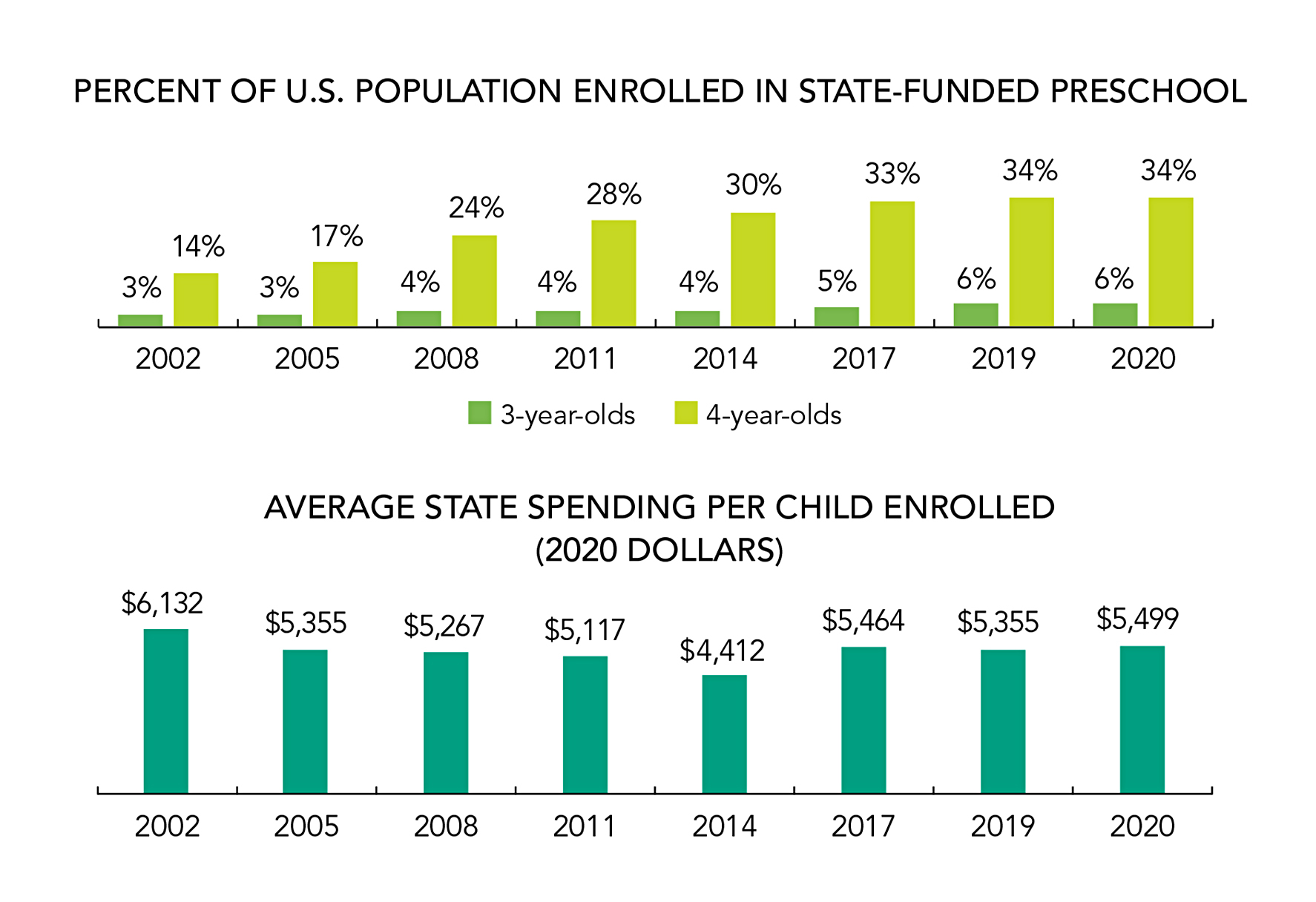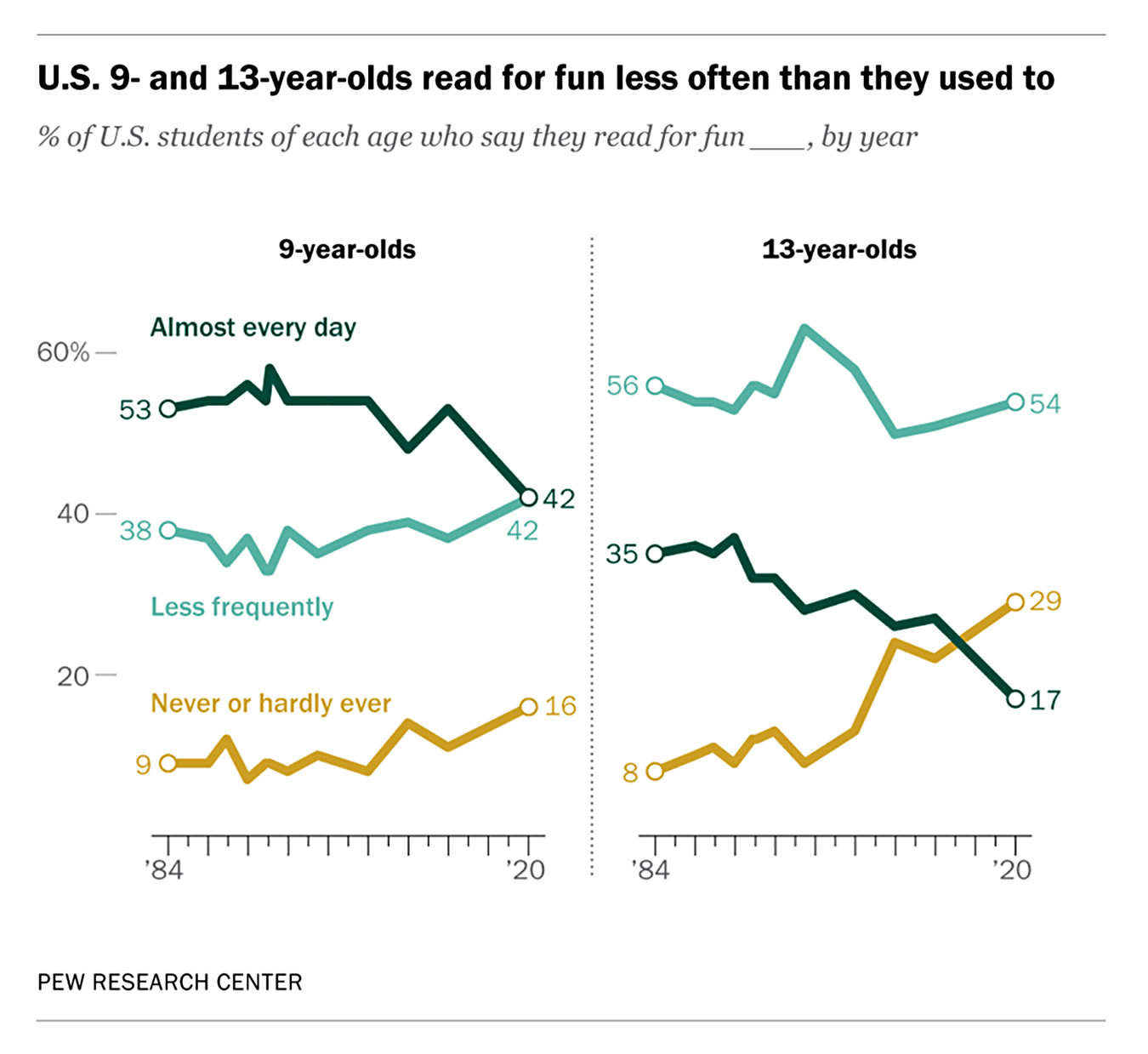First Bell
Pandemic pre-k access, teacher stress levels, 4-day week, and more.
Topics: Pandemic Leadership
Pandemic Affected Preschool Access, NIEER Says
The COVID-19 pandemic impeded access to high-quality preschool programs in the 2019–2020 school year, the National Institute for Early Education Research’s “The State of Preschool 2020” says. Fewer children had access to preschool, and many who did enroll attended virtually.

Source: National Institute for Early Education Research’s “The State of Preschool 2020”
Many preschool programs relaxed their policies to cope with the pandemic, NIEER warns, often moving programs further from meeting recognized quality standards for childhood development. Standards governing staff qualifications, background checks, classroom observation, and child assessment could fall by the wayside as a result.
The report’s top findings include:
- Growth in state-funded preschool started to slow even before the pandemic. States added only 12,000 preschool seats in 2019–2020, and the number of 4-year-olds attending state-funded preschool declined for the second time since 2002. Real funding increased just 3 percent.
- The pandemic reversed recent progress in pre-K. Preliminary estimates say pre-K enrollment and spending fell in 2020–2021, as parents chose not to enroll their children due to fears of in-person exposures and the challenges of remote learning. If preschool funding is based on 2020–2021 enrollments, many states will face serious shortfalls when enrollment rebounds.
- Progress has been uneven among states. Some moved ahead, while others stagnated or declined in access, standards, and funding, increasing inequities in access to high-quality preschool. Six states have no state-funded pre-K program, while others such as Alabama have made great strides in boosting enrollments and meeting quality benchmarks.
- Few states spend enough to support high-quality, full-day pre-K. Only four states—New Jersey, North Carolina, Oklahoma, and West Virginia—and the District of Columbia spend enough per student to pay for high-quality, full-day pre-K. About $12 billion is needed to improve the quality of the existing preschool and Head Start seats nationwide, while $62 billion would be needed to extend preschool to all 3- and 4-year-olds.
- It’s time to invest in high-quality pre-K. Starting with those in the lowest-income families, states should invest federal recovery funds in pre-K to support a return to safe, highly effective programs, the report says. Longer-term, a federal initiative might defray costs and integrate programs into a single system of high-quality pre-K education.
To read “The State of Preschool 2020,” visit bit.ly/3nZLhHH.
Reading for Fun Reaches Historic Lows
Federal data released in November 2021 reveals that reading for fun has become much less common among children over the last decade. The share of American 9- and 13-year-olds who say they read for fun on an almost daily basis is now at its lowest levels since the mid-1980s, says a report from the National Assessment of Educational Progress (NAEP).
Among 9-year-olds, only 42 percent said they read for fun “almost every day,” down from 53 percent in both 2012 and 1984. The 9-year-olds who said they “never” or “hardly ever” read for fun reached their highest point in the history of the survey, 16 percent.

Note: “Less frequently” combines responses of “Once or twice a week,” “Once or twice a month,” and “A few times a year.”
Source: U.S. Department of Education Sciences, National Center for Education Statistics, National Assessment of Education Progress (NAEP), 2020 Long-Term Reading Assessment.
Among the 13-year-olds surveyed, 17 percent said they read for fun “almost every day,” down 10 percentage points from 2012. Nearly one-third (29 percent) said they “never” or “hardly ever” read for fun—up 21 percentage points from the 8 percent who said the same in 1984. About one-quarter (23 percent) said they read for fun once or twice a week.
Female students in both cohorts were more likely to read for fun, while Black students were less likely to read for fun than members of other racial and ethnic groups. Students who performed better on the reading section of standardized tests in 2020 read for fun more frequently.
Visit bit.ly/3oWcBpl for more details.
Successful OST Networks Get Mayors Involved
The Wallace Foundation launched the National Summer Learning Project (NSLP) in 2010 to expand out-of-school-time (OST) opportunities for students whose families were experiencing poverty to understand how summer programs can improve outcomes. A new report based on interviews with officials successful in building coordinated OST networks in four cities (Boston, Dallas, Pittsburgh, and Washington, D.C.) found that:
City mayors were key supporters—setting OST program goals, keeping the various players on task, and attracting funding and media attention.
Programs led by a local OST intermediary (Boston and Dallas) were able to move further along in
their quality improvement work during NSLP.
Challenges included establishing and maintaining buy-in from all stakeholders, keeping them informed, and securing sustainable funding.
Study authors recommend that leaders in other cities who are looking to increase participation in high-quality summer programming set a broad vision that allows for flexibility, get their mayors involved, and consider targeting efforts to neighborhoods where OST need is greatest.
For more on the report, visit bit.ly/3E37PNi.
4-Day Week Comes Up Short
While many districts were forced to get creative with scheduling early in the COVID-19 pandemic, the four-day school week—a strategy that has grown in popularity to alleviate budgetary issues, attract teachers, and reduce student absences—doesn’t always pay off as expected, according to the Brookings Institution. Evidence indicates that:
While teachers generally prefer a shorter workweek and might be encouraged to apply or stay, the cost savings and attendance gains that shortened weeks deliver are minimal.
Instructional time is key to academic achievement. Oregon and Oklahoma experienced negative impacts when schedules failed to maintain equivalent instructional hours in a shortened week.
A shorter school week also reduces student access to meal programs, opportunities for physical activity, and structured social interactions with peers, teachers, and administrators.
To minimize the potential for a four-day schedule to have negative impacts, districts exploring such an option must maintain synchronous and asynchronous learning hours and extracurricular opportunities on the “off” day, Brookings says, while developing new strategies to ensure delivery of nonacademic supports.
For more, visit brook.gs/3E5aKF7.
Early Stereotypes Contribute to STEM Gender Gaps
A majority of children believe girls are less interested in computer science and engineering than boys, according to a new study from the University of Houston and University of Washington, and these early beliefs likely contribute to a gender gap in STEM college courses and careers.
Surveying more than 2,200 children and teens to gauge beliefs about computer science and engineering, researchers found that just over half (51 percent) believed girls are less interested than boys in computer science; nearly two-thirds (63 percent) said girls are less interested in engineering.
Subsequent small-group lab studies demonstrated that girls were significantly less interested in trying a computer science activity when they were told boys were more interested in it than girls (35 percent of girls chose the activity regardless). When told boys and girls were equally interested in the activity, 65 percent of girls chose it.
“Gender-interest stereotypes that STEM is for boys begins in grade school,” said University of Houston professor Allison Master, lead author on the study. “By the time they reach high school, many girls have made their decision not to pursue degrees in computer science and engineering because they feel they don’t belong.”
To read more, visit bit.ly/3cX22Nu.
7:50 a.m.
That’s the hour that Oklahoma City Public Schools considers the optimal start time for elementary schools—30 minutes earlier than the district’s previous average, 8:20 a.m. Planners identified school start times as a problem for middle and high school students, whose bodies and minds are thought to benefit from more sleep. Under a proposed plan, middle schools’ first bells would ring at 9:30 a.m. (20 minutes later than the current average), and high school classes would start at 8:40 a.m. (55 minutes later).

